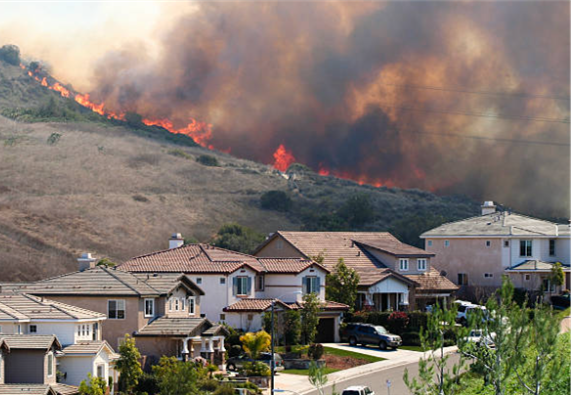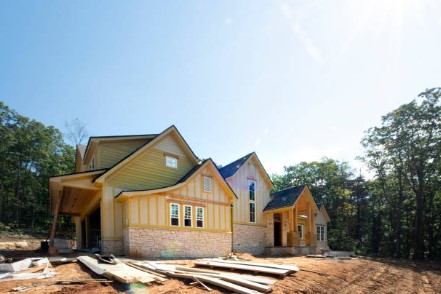Building in the Wildland
Communities located in wildfire-prone areas need to take extra measures to live safely. There are many ways to prepare communities and properties for wildfire that include creating and maintaining adequate defensible space and hardening structures. Using building construction methods that are rated for the wildland it can help reduce the likelihood of building ignition. Protecting your structure by selecting, locating, and maintaining vegetation and other combustible materials on your property can reduce the chance of a wildfire ignition.
How Structures Ignite
Structures ignite during a wildfire because of one or more of these three wildfire exposures:
- EMBERS - Remember the ember! 60 to 90 percent of home ignitions occur because of embers.
- DIRECT FLAMES - The source can be from the wildfire itself or from combustibles near your structure.
- RADIANT HEAT - Structures do not need direct flame contact to ignite. If the radiant heat is high enough, nearby ignition to your structure can occur.

Harden your Home

Defensible Space

Wildland Urban Interface Work Group

Structures ignite during a wildfire because of one or more of these three wildfire exposures:
1. Embers are the most common cause of home ignition. They are small pieces of burning material that are light enough to be blown through the air. They can create spot fires when they land on combustible materials, such as accumulated gutter debris and can enter the home through small openings or vents. It is estimated that between 60 to 90 percent of home ignitions occur because of embers.
2. Direct flame contact refers to flames touching a structure or other combustible materials. It may come either from the main wildfire or from combustible materials near your home. Features like fences and attached decks made from combustible materials often hasten the spread.
3. Radiant heat generated from burning structures or vegetative material can ignite a home without direct flame contact. If the fire is close enough to a combustible material, or the radiant heat is high enough, a home ignition can occur. Radiant heat is particularly challenging in densely populated areas, where the heat from one burning home can ignite the next.
New Construction CBC Chapter 7A Materials and Construction Methods for Exterior Wildfire Exposure
What is the purpose?
The purpose of the California Wildland-Urban Interface Code is to establish minimum standards for the protection of life and property by increasing the ability of a building to resist the intrusion of flames or burning embers projected by a vegetation fire and contributes to a systematic reduction in conflagration losses. The California Wildland Urban Interface Codes can be found in the California Building Code, Chapter 7A — Materials and Construction Methods for Exterior Wildfire Exposure.
Application Date and Where Required?
The California Wildland-Urban Interface Code applies to all new buildings for which an application for a building permit is submitted on or after July 1, 2008 and are located in the following areas:
All unincorporated lands designated by the State Board of Forestry and Fire Protection as State Responsibility Area (SRA) including:
- Moderate Fire Hazard Severity Zones.
- High Fire Hazard Severity Zones.
- Very-High Fire Hazard Severity Zones.
Land designated as Very-High Fire Hazard Severity Zone by cities and other local agencies.
Land designated as Wildland Interface Fire Area by cities and other local agencies. Always consult your local building official to determine the California Wildland-Urban Interface Code requirements for your area. For additional information on CAL FIRE’s Fire Hazard Severity Zones (FHSZ) or additional information on where the California Wildland-Urban Interface Codes apply.
Vegetation Management Compliance
The California Wildland-Urban-Interface Code requires prior to a building permit final approval, that the property must be in compliance with required vegetation management requirements. For more information see Code Vegetation Management Compliance or Defensible Space.
Minimum building standards were established for the protection of life and property to resist the intrusion of flames or burning embers. Each section outlines the codes requirements for new construction in the FHSZ or Wildland Interface.
CBC Chapter 7A Materials and Construction Methods for Exterior Wildfire Exposure
Section 705A Roofing
Section 706A Vents
Section 707A Exterior Coverings
Section 708A Exterior Windows, Skylights, and Doors
Section 709A Decking
Section 710A Accessory Buildings and Miscellaneous Structures
Other Considerations
Local jurisdictions can amend the California Building Code, so always consult your local building official and hire a licensed contractor who understands Chapter 7A. Consider Chapter 7A complaint products when you are replacing an exterior building component.
Helpful Resources
STATE FIRE MARSHAL WUI PRODUCTS HANDBOOK
OSFM BUILDING MATERIALS LISTING
What is the California Wildfire Mitigation Program?
To strengthen community-wide resilience against wildfires, the California Governor’s Office of Emergency Services (CAL OES) has partnered with CAL FIRE to develop a state home hardening initiative to retrofit, harden, and create defensible space for homes at high risk to wildfires, focusing on high socially-vulnerable communities and providing financial assistance for low– and moderate income households.
Visit the CAL OES CWMP page for programmatic information and how to apply
OSFM CWMP Board Meeting Information webpage
What is Hazard Mitigation Methodology?
The National Institute of Standards and Technology (NIST), CAL FIRE, and the Insurance Institute for Business and Home Safety (IBHS) collaborated developing the HMM to use the latest laboratory research findings and knowledge from post-fire field observations to effectively harden structures.
The proposed method has two goals:
1. Protect homes and property to reduce loss,
2. Prioritize cost-effective protection.
Learn more about HMM and hardening actions with construction guidance below.
WUI Fire Safety Building Standards Compliance Training is in development.
Course Goals:
- Provide local building officials, builders, and fire service personnel online training on how to access, interpret, and comply with the California Building Code Chapter 7A Materials and Construction Methods for Exterior Wildfire Exposure.
- Provide local building officials, builders, and fire service personnel online training on how to access and utilize the CAL FIRE Office of the State Fire Marshal's (SFM) Building Materials Listing Program (BML), Building Materials Listing Search Tool and State Fire Marshal Listed Wildland Urban Interface (WUI) Products Handbook.
- Provide a building officials, builders, and fire service personnel documentation for completion of the online training.
- Low-Cost Retrofit List
- OSFM WUI Products Handbook
- Building Materials Listing
- Fire Hazard Severity Zone
- Land Use Planning
- Home Hardening and Defensible Space Self-Assessment
- Wildfire Action Plan
- Strategic Fire Plan for California
- Ready for Wildfire
- Wildfire Prepared –A Program of IBHS
- Construction Cost for a Wildfire-Resistant Home - Headwaters Economics